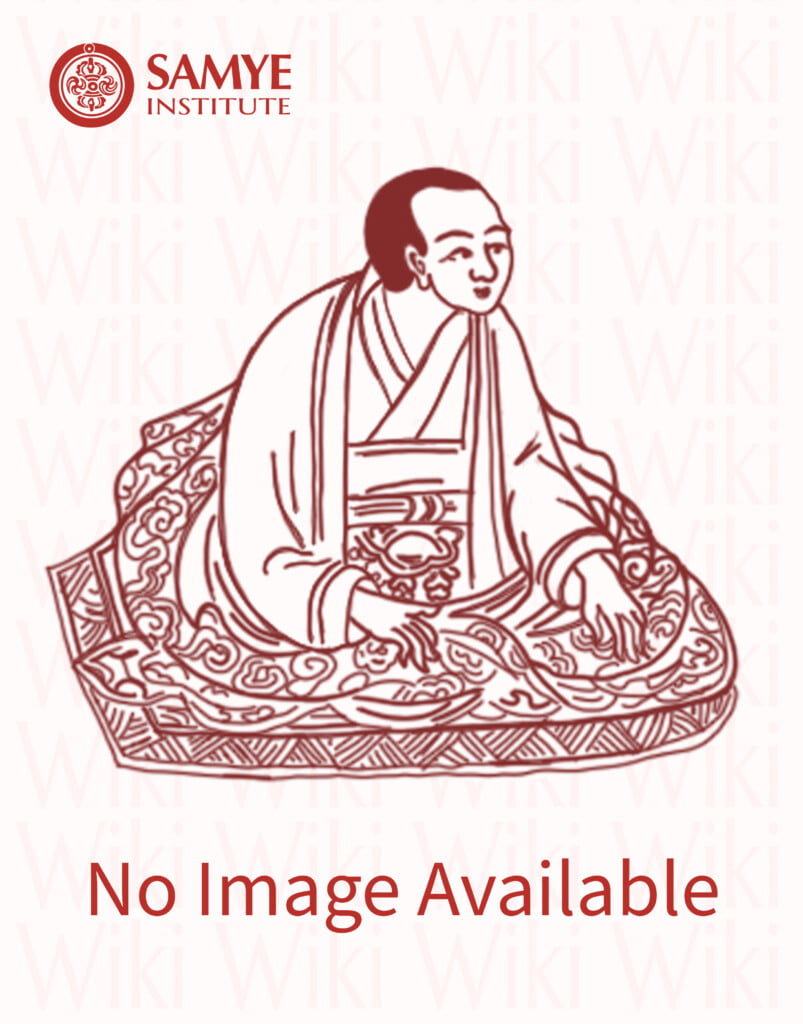Karma Rinchen Dargyé (b. 1835-d. unknown), also known as Karmé Khenpo, was recognized at an early age as the reincarnation of a Kagyü lineage master whose seat was Karma Monastery in Kham. He was known to observe monastic discipline with the greatest diligence. A close disciple of Chokgyur Lingpa, he was also one of his main lineage holders. Many of his commentaries have been included in the Chokling Tersar collection. and his own collected works constitute four volumes.
The great tertön Chokgyur Lingpa, in his Advice on Nonsectarianism, praised this disciple highly, recommending him as an exemplary scholar-practitioner. He wrote:
One of my students—a Vinaya-holder of these degenerate times, Karma Sangyé Chöpel, or Péma Drimé Lodrö Zhenpen Chökyi Nangwa [other names for Karmé Khenpo] has visited all the Dharma centers and remote mountain hermitages of the foremost scholars and practitioners. He has toured their monks’ colleges to engage in study and reflection, and stayed in their retreat centers to enhance his practice of the essential points of Sūtra and Tantra. Since serving the Dharma with pure, virtuous altruism forms part of the seven accumulations of merit from material causes, all decent people—high, low, and middling—should seek him out! Not only that, but in these times when people hold to mere appearances, the only attachment of this master from Ewam Chögar is to the beneficial qualities of the steadfast scholar. Therefore, wherever you hail from—whether lay person, novice or pre-novice, or fully-ordained monastic—if you are interested in the Vinaya of the sublime Dharma, you should know him to have the undeniable status of a khenpo!
From Advice on Nonsectarianism by Chokgyur Lingpa, translated by Samye Translations.
Reincarnation of Śāntarakṣita, Lord Mahāpaṇḍita Ratna
This line refers to Karmé Khenpo Rinchen Dargyé. [Paṇḍita is the Sanskrit equivalent of khenpo, while ratna is Sanskrit for rinchen.] He was a reincarnation of the great Paṇḍita Śāntarakṣita, commonly known to Tibetans as Khenpo Bodhisattva. Śāntarakṣita came from the Indian country of Zahor and was the very first master to be invited to assist with the construction of Samyé in Tibet. Karmé Khenpo was often compared to Karmé Chagmé in terms of caliber. He had his own seat at the great monastery of Karmé Gön in Kham and, although he was a disciple of Chokgyur Lingpa, his background was Karma Kagyü.
Karmé Khenpo was an extraordinary master and looked just like one of the sixteen arhats. He was a completely pure monk and never let meat or alcohol touch his tongue his entire life. He said, moreover, that his hand had never even touched a woman. They say he never permitted a lie to cross his lips. Yet, even though he was so gifted and quite close to Chokgyur Lingpa, he still didn’t have the good fortune to receive the Three Sections of the Great Perfection in person. However, when the great tertön passed away, Karmé Khenpo did have a vision of Chokgyur Lingpa’s wisdom-body — and at that stage received the complete empowerments and transmissions from him.
Karmé Khenpo was an exceptionally great master. Even Düdjom Rinpoché was amazed by his writings and once told me: “It’s so wonderful that someone like Karmé Khenpo could even exist in this world!” He lived, I believe, into his early eighties, and was then reborn as the son of Samten Gyatso’s sister.
Tulku Urgyen Rinpoche in The Great Tertön: The Life and Activities of Chokgyur Lingpa, Lhasey Lotsawa Translations, 2016, pp. 371-72.
Supplication to Karmé Khenpo Rinchen Dargyé
དམ་པ་གསུམ་གྱིས་རང་རྒྱུད་ལེགས་སྨིན་ནས། །
dampa sum gyi rang gyü lek miné
With the three perfections you ripened your being andསྡོམ་པ་གསུམ་གྱི་ཚིག་དོན་གཞན་ལ་འཆད། །
dompa sum gyi tsik dön zhen la ché
expounded to others the three vows’ meaning;བསླབ་པ་གསུམ་གྱིས་བསྟན་པའི་རྒྱལ་མཚན་འཛིན། །
lapa sum gyi tenpé gyeltsen dzin
with the three trainings you hoist the banner of the doctrine—མཁན་ཆེན་བསྟན་པའི་ཉི་མར་གསོལ་བ་འདེབས། །
From Supplications to the Chokling Tersar Lineage Gurus, Rangjung Yeshe & Lhasey Lotsawa Translations (trans. Erik Pema Kunsang, checked against the Tibetan by Laura Dainty and Oriane Sherap Lhamo, and ed. by Libby Hogg), June 2020.
khenchen tenpé nyimar sölwa dep
Great Khenpo, light of the teachings, to you I pray.



